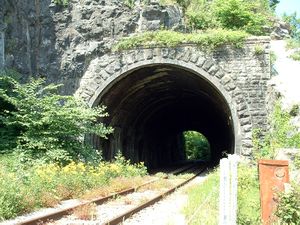Portishead Railway
The Portishead Railway was a railway which ran from Portishead to the Great Western Main Line in Bristol, England.
The line was officially known as the Bristol & Portishead Pier and Railway[1]. It was incorporated to build a pier and a 10 mile broad gauge link to the Bristol and Exeter Railway at Bedminster Down.[1]
The line opened on 12 July 1867 and was extended to the docks on 5 July 1879.[1] In 1876 Isambard Kingdom Brunel's Great Western Railway took over the Bristol and Exeter Railway and operated the Bristol & Portishead Pier & Railway for 40 percent of the receipts.[1]
On 1 July 1885 the GWR bought the Portishead Railway and it became a branch line of the GWR to serve the pier and dock at Portishead, from which Brunel's steamships sailed to North America. In 1880 it was converted from GWR's seven foot gauge to standard gauge. Passenger services were discontinued in 1964 as part of the Beeching Axe, and freight was discontinued in 1981, but the railway was not dismantled.
The railway branches from the mainline at Bedminster/Ashton Gate in south Bristol and runs north along the south west bank of the River Avon. The first station was Ashton Gate, opened 1906, followed by Clifton Bridge, half a mile south of the Clifton Suspension Bridge, near the Cumberland Basin and modern Brunel Way road. In the Avon Gorge the railway runs through a short tunnel where the Clifton Suspension Bridge runs overhead. In 1928 a halt was opened at Nightingale Valley, a footpath which leads up to the Leigh Woods suburb of Bristol, but this was closed four years later. The railway then crosses the flood plains south of the Avon estuary on an embankment, passes through another short tunnel and across a viaduct at Pill. Ham Green Halt, serving a now demolished hospital just east of Pill, opened in 1926. There were then stations at Pill, and Portbury. From there the line then runs west to Portishead. In the 1920s a second Portishead Station was built to serve a planned shipyard, though this was never built and the station soon closed. In 1954 the original Portishead station was demolished, to give access to the new Portishead power station, and a new station constructed in a new location, lasting only a decade before the line stopped carrying passengers.
Between 2000 and 2002 the railway was repaired as far as Pill, and a short spur constructed to the Royal Portbury Dock to transport freight, at a cost of £21 million. Local politicians and organisations have been campaigning to have the remaining 3.3 miles (5.3 km) repaired and a new station constructed at Portishead. The coastal town largely serves as a dormitory for Bristol workers, and the main route into the city, a single carriageway, is often unable to cope with the volume of commuter traffic. When current construction work is completed Portishead will be the largest settlement in the country without a link to the rail network. The Department for Transport currently do not support the proposals, estimating the costs to be too high at £17 million, and because of scheduling complications due to its use by freight trains. The 2006-2011 Joint Local Transport Plan reserves £1 million for the project.
Notes
External links
Sources
- Awdry, Christopher, (1990). Encylopaedia of British Railway Companies. London: Guild Publishing.
- Portishead Railway Group, 2006. "History of the Portishead Railway." Accessed 2006-04-15.
- Trascript of House of Commons debate on reopening the railway, 24 January 2005
- Local Transport Plan (Ch 3, P 51)

